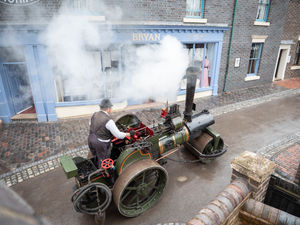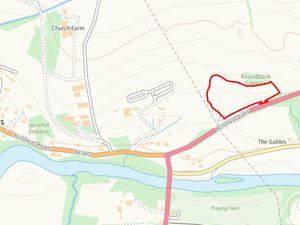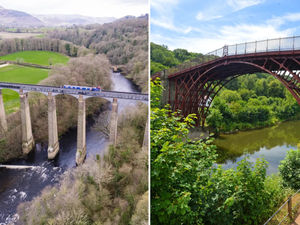Historic Shropshire buildings get £80 million revamp
The scaffolding around the ruins of Wenlock Priory glistens in the sunlight on this bright spring morning. A team of men in hard hats are busy at work injecting lime grout into the fine detail of the 13th century south transept.
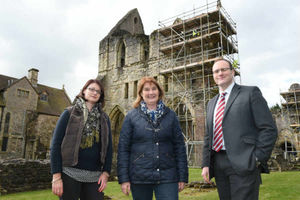
The centuries have taken their toll, and were it not for the work that is being carried out at the moment, there is a real danger that nature could destroy what Henry VIII left intact, and wipe out what remains of this beautiful corner of Shropshire.
"There's a lot of detail work in there, and it's become quite fragile," says English Heritage's Joanna Hall, who is overseeing the work. "A lime grout is being used to stabilise the stone, and we're then using lime mortar as a sealant to stop the water getting in."
From tomorrow, English Heritage will see the biggest shake-up in its 32-year history, when the organisation will split into two. Its statutory role, which provides advice regarding the preservation of historic buildings and monuments, will continue under the new name Historic England.

English Heritage was founded in 1983, taking over responsibility for the maintenance of ancient monuments Today, it is responsible for managing the National Heritage Collection, which comprises 400 sites across England.
Under the proposed changes, the buildings and monuments – which include the Iron Bridge and Stonehenge – will remain the property of the Government. But day-to-day management will be delegated to English Heritage, which will become a self-funding charity.
Until now, English Heritage has seen most of its funding come from taxation. In 2010–2011, it had a total income of £184.7 million, with 70 per cent coming from the Government in the form of grant aid.
However, Government funding has seen a steady decline since 1997, resulting in a real-terms reduction of £130 million since 1997.
However, it is the arm which looks after sites such as Wenlock Priory which will see the biggest change. The English Heritage name will be retained for the organisation responsible for the upkeep and maintenance of national treasures such as the Iron Bridge, the Roman city of Wroxeter and Boscobel House. However, from now on, it will become an independent charity responsible for managing its own funds – and to set the ball rolling the Government is stumping up £80 million for historic sites over the next eight years.
The change is being billed as the biggest conservation and repair programme in the organisation's history. In the West Midlands, it will see the amount of money earmarked for conservation maintenance on the region's 43 English Heritage properties more than double from £242,000 in the present financial year, to £560,000 next year.
But what about the longer term?
Alex Page, regional director of English Heritage, is the man responsible for seeing the plan put into action, and he says it marks the beginning of an exciting new chapter for the area's historic treasures.
"Our business plan is for us to be self-sufficient in eight years," says Mr Page. "We are very good at selling membership, and it will mean that we will improve our retail operations generate funds."
Cynics may wonder whether the need to generate funds could lead to the need to increase charges for visitors to sites such as Wenlock, but Mr Page is adamant that this will not happen. "We review prices every year. There will be the same year-on-year increases as we have always had in line with administration costs, but we won't be putting the fees up by any significant amount," he says.

Mr Page says that the extra Government funding will allow the charity to carry out a backlog of repairs which have been built up over the years.
Work has already begun on a £200,000 restoration project at Boscobel House in Bishop's Wood, near Brewood, which became famous as the hiding place for King Charles II following his defeat at the Battle of Worcester in 1651.
"We carried out some survey work, and found we needed to do some repairs to the timber work of the 17th century house," says Mr Page.
Work has now begun replacing the decaying timber beams with steel supports, and the external rendering will be replaced to preserve the building for generations to come.
But the plan to make English Heritage self-sufficient will also depend on attracting more visitors, particularly at the manned attractions such as Wenlock and Boscobel which are crucial to raising revenue. And English Heritage has set some ambitious targets.
"Shropshire has got six manned properties, attracting a total of around 100,000 visitors a year," says Mr Page. "Visitor numbers are expected to grow by five per cent over the course of the next eight years."
Mr Page says part of this will be down to investing in the properties over the next few years.
"At Kenilworth Castle, we have invested over the past seven years on viewing platforms and the Elizabethan gardens, and that has really increased the numbers there," he says.
"We're working to bring more detail and interpretation to our small and medium properties."
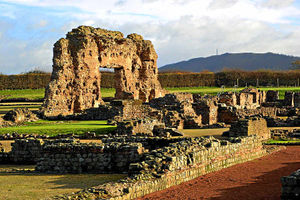
He also points to the investment at Witley Court, near Stourport-on Severn – English Heritage's largest manned attraction in the West Midlands – which has seen visitor numbers rise by more than 5,000 a year, to present a figure of around 60,000.
Nationally, the Government has set a target that by 2026/27 individual membership will grow by 86 per cent to 1.3 million and that the number of visitors per year will increase by 31 per cent to 6.8 million.
The plan has not been without its critics. Last year the Heritage Alliance warned that visitor figures are notoriously volatile, as events such as the outbreak of foot and mouth disease in 2001 and 9/11 have shown.
"The charity may build its reserves in time, but before that, it would only take one or two significant events to derail this model, hence our concern for contingency planning," it warned.
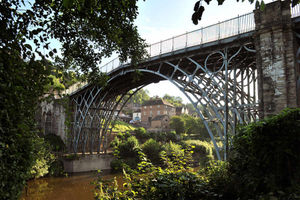
Back at Wenlock Priory, English Heritage curator Heather Sebire says there has been considerable interest in the repair work from visitors.
"People don't see it as getting in the way, they are actually interested in what is going on, they see it as adding to the experience," she says.
In the next few weeks the scaffolding will be removed from the south transept, and will move to St Michael's Chapel, where further restoration work will take place, due to be complete by the summer.
Mrs Sebire adds: "
People love coming to sites such as Wenlock Priory because they are so tranquil, and Wroxeter is very interesting for research work. Witley is completely different, and that is the strength here, we have got so much that appeals to different audiences."

